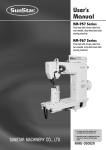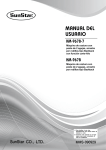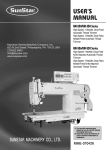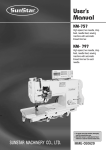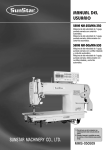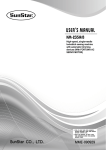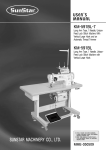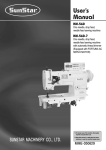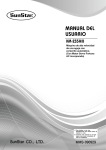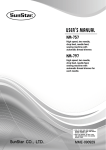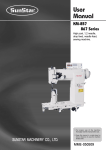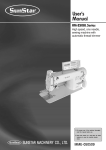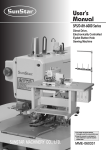Download User's Manual
Transcript
User’s Manual KM-640BL-7 Long arm type, one-needle, upper & lower feed lock stitch machine with automatic thread trimmer with large hook KM-640BL Long arm type, one-needle, upper & lower feed lock stitch machine with large hook 1) For proper use of the machine, thoroughly read this manual before use. 2) Keep this manual in a safe place for future reference in case the machine breaks down. SUNSTAR MACHINERY CO., LTD. MME-050629 lity a u tQ Besst Pricevice Be st Ser Be 1. Thank you for purchasing our product. Based on the rich expertise and experience accumulated in industrial sewing machine production, SUNSTAR will manufacture industrial sewing machines, which deliver more diverse functions, high performance, powerful operation, enhanced durability, and more sophisticated design to meet a number of user’s needs. 2. Please read this user’s manual thoroughly before using the machine. Make sure to properly use the machine to enjoy its full performance. 3. The specifications of the machine are subject to change, aimed to enhance product performance, without prior notice. 4. This product is designed, manufactured, and sold as an industrial sewing machine. It should not be used for other than industrial purpose. R SUNSTAR MACHINERY CO., LTD. Table of Contents Safety rules for machines ..................................................................................................................................... 4 1. Specification ............................................................................................................................................................ 8 1) Sewing machine ......................................................................................................................................................... 8 2) Servo motor ................................................................................................................................................................ 8 3) 470 motor ................................................................................................................................................................... 8 4) 470 motor controller ................................................................................................................................................... 9 5) Clutch motor ............................................................................................................................................................... 9 6) Peripheral automation devices (optional) .................................................................................................................. 9 2. Installation .............................................................................................................................................................. 10 1) Installation of machine head .................................................................................................................................... 10 2) Installation of power switch box ............................................................................................................................. 10 3) Lubrication ............................................................................................................................................................... 11 4) Adjustment of belt tension ....................................................................................................................................... 11 5) Installation of program unit (for automatic trimming type) ................................................................................... 12 6) Installation of belt cover .......................................................................................................................................... 12 7) Installation of synchronizer (for automatic trimming type) ................................................................................... 12 8) Check for machine stop position (for automatic trimming type) ........................................................................... 13 9) Reverse button function ........................................................................................................................................... 14 10) Adjustment of synchronizer .................................................................................................................................. 14 3. Machine Adjustment ......................................................................................................................................... 15 1) Inserting needle ....................................................................................................................................................... 15 2) Adjusting needle bar ................................................................................................................................................ 15 3) Adjusting timing of needle and hook ...................................................................................................................... 15 4) Adjusting lubrication of thread take-up spring part ................................................................................................ 16 5) Adjusting lubrication of hook .................................................................................................................................. 16 6) Winding and adjusting lower thread ........................................................................................................................ 17 7) Inserting and removing lower thread and adjusting tension ................................................................................... 17 8) Routing upper thread ................................................................................................................................................ 18 9) Adjusting upper thread ............................................................................................................................................. 18 10) Adjusting presser foot pressure ............................................................................................................................. 19 11) Adjusting stitch length ........................................................................................................................................... 19 12) Adjusting feed dog height and inclination ............................................................................................................ 20 13) Adjusting auxiliary presser foot and upper feed presser foot ............................................................................... 20 14) Adjusting feeding amount of auxiliary presser foot ............................................................................................. 21 15) Adjusting feed cam ................................................................................................................................................ 22 16) Adjusting for thread trimmer ................................................................................................................................. 22 17) Adjusting blade pressure ........................................................................................................................................ 26 18) Exchanging movable knife .................................................................................................................................... 26 19) Exchanging fixed blade ......................................................................................................................................... 26 20) Adjusting thread release ......................................................................................................................................... 27 21) Adjusting remaining amount of upper thread ....................................................................................................... 27 4. Causes of Troubles and Troubleshooting ............................................................................................. 28 1) Sewing machine troubleshooting ............................................................................................................................ 28 5. Table drawing ........................................................................................................................................................ 29 1) KM-640BL ............................................................................................................................................................... 29 2) KM-640BL-7 ........................................................................................................................................................... 30 Safety Rules for Machines Safety labels in the manual are categorized into danger, warning and caution. Failure to follow the safety rules may result in physical injuries or mechanical damages. The safety labels and symbols are defined as follows. [The meaning of the safety labels] Danger Instructions here shall be observed strictly. Otherwise, the user will be killed or suffer severe physical injuries. Warning Instructions here must be observed, or the user could suffer fatal or severe physical injuries. Caution Instructions here should be observed, or the user could face physical injuries or mechanical damages. [The meaning of symbols] This symbol means a must-not. This symbol means a must for safety. This symbol means that an electric shock may be caused if the instruction is not followed properly. 4 1-1) Machine mobilization Danger 1-2) Machine Installation Caution Only personnel with a full understanding of the safety rules should move the machine. The following directions must be observed when transferring the machine. ⓐ At least 2 persons should move the machine together. ⓑ In case the machine should be transported, wipe the oil covered on the machine to prevent accidents. Because physical damages such as the machine’s dysfunction and breakdown are likely to occur depending on the environment in which the machine is installed, the following preconditions must be met. ⓐ Please unpack the machine package in order. Be particularly careful of the nails in the wooden box. ⓑ Because machines are apt to be contaminated and corroded by dust and moisture, install a climate controller and clean the machines regularly. ⓒ Keep the machine out of direct rays of the sun. ⓓ Keep both sides and the backside of the machines at least 50cm from the wall to secure enough space for repair. ⓔ Danger of Explosion Don’t run the machine near places with any danger of explosion. Don’t run the machine near places with any danger of explosion, including places where sprays like aerosol are used in large quantities or oxygen are dealt with, unless the exact actions concerning the operation are guaranteed to avoid the explosion. ⓕ Illuminators do not come equipped with the machine due to the machine’s characteristics. So, users should install the lighting apparatus around the working area. [Note] The details about the installment of the machine are described in No. 2 Installations. 1-3) Troubleshooting Danger If in need of troubleshooting, call a trained A/S engineer who has been educated by Sunstar. ⓐ Be sure to turn the power off before cleaning and repair. And wait for about 4 minutes until the machine discharges completely. ⓑ Part of or the entire machine should not be modified without any consultation with our company ⓒ In case of repair, change the damaged part into the genuine part of our company ⓓ After repair, cover the machine with the safety cover that was removed for repair. 5 1-4) Machine Operation Caution The KM-640BL Series are manufactured for industrial use to sew textiles and other similar material. When running the machine, users should observe the following things. ⓐ Read the manual before operation of the machine to fully understand the details about its operation. ⓑ Do not forget to wear garment suitable for safe work. ⓒ Keep your hands or any part of the body away from the running part of the machine like needle, hook, thread take-up spring, pulley, etc. ⓓ Do not remove any type of cover during operation for safety reasons. ⓔ Be sure to connect the earthed line. ⓕ Before opening an electric box such as a control box, be sure to shut off the power supply and make sure that the power switch is set to“off.” ⓖ Be sure to stop the machine when threading the needle or before checking after sewing. ⓗ Do not switch on the power supply with the foot on the pedal. ⓘ Do not run the machine when the cooling fan is clogged. Be sure to clean the air filter in the control box once a week. ⓙ If possible, keep the machine away from strong electromagnetic fields like areas around a high frequency welding machine. Caution 1-5) Safety Device Caution Always start the machine with safety covers in place since fingers or hands could be injured or cut off by the belt. Turn off the power switch during check-ups or adjustments. ⓐ Safety Label: Cautions that need to be heeded to during operation. ⓑ Thread take-up spring cover: a device to prevent the human body from touching the thread take-up spring. ⓒ Belt cover: a device to prevent hands, feet and clothing from getting jammed by the belt ⓓ Finger guard: a device to prevent fingers from contacting the needle. ⓑ ⓐ ⓒ ⓓ 6 1-6) Position of Caution Mark CAUTION 경 고 “Caution”is attached to the machine for safety. In case of starting to run the machine, read the directions of“Cautions”carefully. [Position of Caution Mark] Do not operate without finger guard and safety devices. Before threading, changing bobbin and needle, cleaning etc. switch off main switch. 손가락 보호대와 안전장치 없이 작동하지 마십시오. 실, 보빈, 바늘교환시나 청소전에는 반드시 주전원의 스위치를 꺼 주십시오. CAUTION 경 고 Hazardous voltage will cause injury. Be sure to wait at least 360 seconds before opening this cover after turn off main switch and unplug a power cord. 고압 전류에 의해 감전될 수 있으므로 커버를 열 때는 전원을 내리고 전원 플러그를 뽑고 나서 360초간 기다린 후 여십시오. 1-7) Content of “Caution” Caution CAUTION 경 고 Do not operate without finger guard and safety devices. Before threading, changing bobbin and needle, cleaning etc. switch off main switch. 손가락 보호대와 안전장치 없이 작동하지 마십시오. 실, 보빈, 바늘교환시나 청소전에는 반드시 주전원의 스위치를 꺼 주십시오. CAUTION 경 고 Hazardous voltage will cause injury. Be sure to wait at least 360 seconds before opening this cover after turn off main switch and unplug a power cord. 고압 전류에 의해 감전될 수 있으므로 커버를 열 때는 전원을 내리고 전원 플러그를 뽑고 나서 360초간 기다린 후 여십시오. 7 1 Specification 1) Sewing machine KM-640BL-7: Long arm type, one-needle, upper & lower feed lock stitch machine with automatic thread trimmer with large hook KM-640BL: Long arm type, one-needle, upper & lower feed lock stitch machine with large hook Model Name KM-640BL-7 Item Speed KM-640BL Max 2,000 SPM Max stitch length Max 2,500 SPM Max 9mm Needle DP×17 #22, DB×1 #22 Thread take-up stroke 73mm Needle bar stroke 38mm Presser foot stroke 2∼5.5mm Presser foot ascending amount Manual 7mm Auto 16mm Hook Vertical rotation hook Usage Heavy materials 2) Servo motor MODEL VOLT WATT HERTZ SC55-1A 1 Phase 110V 550W 50/60 Hz SC55-2A 1 Phase 220V 550W 50/60 Hz SC55-3A 3 Phase 220V 550W 50/60 Hz 3) 470 motor MODEL PM470 8 PHASE HERTZ VOLT 4) 470 motor controller MODEL VOLT MODEL SUB CLASS MODEL VOLT WATT HERTZ HEC-1701 1 Phase 220V 250W 50/60 Hz HEC-1703 3 Phase 220V/380V 250W 50/60 Hz HEC-1705 3 Phase 220V 400W 50/60 Hz HEC-1706 1 Phase 220V 400W 50/60 Hz 5) Clutch motor 6) Peripheral automation devices (optional) Optional device Model Usage AUTO KNEE LIFTING SYSTEM SPF-7 PRODUCTION COUNTER SCOUND-1 A counting device, which indicates the completed quantity on the program unit panel, including added, subtracted, corrected or remaining quantity along with other performance rates. MATERIAL EDGE SENSOR SEDG-1B SEDG-2B A device that senses the edge or thickness of the sewing material to stop the machine without manual pedaling. Available in two types: SEDG-1B for edge sensing type and SEDG-2B for thickness sensing type. STANDING PEDAL SPDL-1 SPDL-2 An essential device when one person is operating multiple sewing machines. Has different pedals for acceleration, thread trimming, presser foot and ascending pedal. Types consist of SPDL-1 and EDPL-1 for fixed speed, and SPDL-2 and EDPL-2 for variable speed. A solenoid operating structure where the presser foot gets lifted automatically with pedal reverse gear stage 1 operation. Servo motor 470 motor 9 2 Installation Warning ▶ Installation of the machine should be performed by a trained engineer. ▶ Any electrical wiring must be performed by a qualified technician or agent. ▶ The machine weighs over 43kg. At least 2 persons should carry out the installing work. ▶ Plug in after the installation is complete. ▶ If the operator mistakenly steps down on the pedal with the pug in, the machine will start automatically and can cause physical injuries. ▶ Connect the ground (earth) wire. ▶ An unstable connection may result in an electric shock or a malfunction. ▶ Place the belt cover on top of the machine. ▶ Use both hands when bending the machine backwards or returning it to the normal position. Using only one hand can lead to severe hand injuries due to the weight of the machine. 1) Installation of machine head Insert the hinge rubber① into the table. After inserting the oil tray in the middle of head supporting rubber B② as shown in the figure 1, install it into the table. Insert the machine head hinge③ into the bed holes. By inserting it into the hinge rubber ①, stand the machine on the head support rubber A④ and the head support rubber B②. oil tray (oil fan) [Figure 1] 2) Installation of power switch box When attaching the power switch box ①, refer to Figure 2 to make sure that it is placed at the lower right of the table. [Figure 2] 10 Caution ▶ Plug in only after oil supply is finished. ▶ If the operator mistakenly steps on the pedal with the plug in, the machine will start automatically and can cause severe injuries. ▶ When handling lubricants, wear protective glasses or gloves to avoid contact with your eyes or skin. Inflammation may be caused otherwise. Never drink lubricants since they can cause vomiting or diarrhea. Keep out of the reach of children. ▶ Operate the machine only after adding oil when the machine is being used for the first time or has been left unused for a long time. 3) Lubrication Attachment of magnet for sweeping up chips Attach the magnet for sweeping up chips included in the accessory box to the oil pump inside of the bed. ※ Do not use the magnet for other usages. Running the sewing machine without the magnet could cause mechanic problems and affect the endurance of the machine. Inserting lubricant to oil tray (oil fan) a) Fill the lubricant to“HIGH”position. (Refer to Figure 4) b) Please use SUNSTAR lubricant exclusive for industrial sewing machine or SHELL’s TELLUS C10. c) When the lubricant in use is at LOW position, fill it immediately to HIGH position. d) Most suitable period of changing lubricant is 1 time in two weeks. magnet oil pump [Figure 3] [Figure 4] 4) Adjustment of belt tension After installing the motor, unfasten the fixing nuts①,② up and down and tension will be created to the belt④ due to motor③ falling by gravity. Fasten the fixing nut① first, and then fasten tight the fixing nut②. [Figure 5] 11 5) Installation of program unit (for automatic trimming type) Fix the bracket② onto the program unit①, using 4 fixing nuts③. Then, use 2 fixing bolts④ to tightly fix the bracket②, where the program unit ① has been adjusted, along with the back cover. [Figure 6] 6) Installation of belt cover Fix the belt cover“A”① to the machine’s body using 3 fixing screws②. You can assemble it more easily if you slightly incline the machine. When the assembly of the belt cover“A”is finished, insert the front side of the belt cover“C”③ into the groove of belt cover“A”① and fix the back side with the fixing screw④. Attach the belt cover“B”④ to the table. Please make sure that the belt do not intervene with the inside of the belt cover“B” ④. [Figure 7] [Figure 8] 7) Installation of synchronizer (for automatic trimming type) Installing on the servo motor In case of installing the servo motor (in-built synchronizer), a synchronizer sensor is attached to the backside of the arm. The appropriate clearance between the synchronizer and the pulley is 1.2mm. [Figure 9] 12 Installing on the 470 motor Assemble the parts in numerical order as shown in Figure 10. Later, adjust the synchro shaft by moving it horizontally so that the photo film is located at the center of the photo interrupt. Then, fasten tightly with the two fixing bolts using a hexagonal wrench. [Caution] a) Start assembling, after confirming that“DOWN”and“UP”marks are located in the frontal side from the pulley as shown in FIGURE 10. b) Film adjustment is already set up in time of delivery. pulley Speed sensor film Synchronizer Fixing shaft washer Fixing washer Fixing bushing Fixing screws L-wrench synchro shaft fixing screws (2) synchro shaft photo film photo interrupt Clearance adjustment bushing cover PC beholder [Figure 10] [Figure 11] In case of using sewing machines that have not been used for a long time, or new products delivered a long time ago, open the face plate and spray oil using lubricator to the thread take-up connecting part ① and fraction parts such as needle bar ② and pushing bar ③. When you do test running of machines, run intermittently the machines for about 10 minutes at rotation of 1,500 spm. For the first 4 to 5 days, run the machine less than 1,500 spm per minute, and later, run the machine at the normal rotation so that the machine can maintain its excellent function. [Figure 12] 8) Check for machine stop position (for automatic trimming type) Check for the machine stop position after moving the needle up and down by pushing the reverse button. See whether the carved line of pulley is aligned with the carved line of arm when the needle is in an up position. If not, adjustment to the location of the magnetic holder or to the photo film of the synchronizer will be necessary. The needle’s up-stop position should be identical with the stop position of the needle bar after the trimming operation. Carved line White carved sign Reverse button [Figure 13] 13 9) Reverse button function Pressing the reverse button during forward sewing will start reverse sewing immediately. When you stop the machine and restart it by stepping down on the pedal with the reverse button already pressed down, you can perform reverse sewing from the beginning. When the machine is in a“stop”mode, you can change the up-down position of the needle bar by pressing the button. Lightly pressing the button once when the needle is in a down-stop position will stop the needle bar in a high position. Pressing the reverse button twice within less than a second when it is in an up-stop position will stop the needle bar in a low position. up-stop position down-stop position [Figure 14] 10) Adjustment of synchronizer For in-built synchronizer Adjust the up-stop position of the needle by loosening the clamp screw① on the side with N(U carved signs and moving it sideways such that the white carved sign③ on the pulley is aligned with the carved sign of arm④ when the machine is in up-stop position. Adjust the down-stop position of the needle by loosening the clamp screw② on the side with N.D carved signs and moving it sideways such that the needle bar stops in the point where it is about to up in the lowest position when the machine is in down-stop position. (Refer to figure 15 and 16) up-stop position down-stop position [Figure 16] [Figure 15] For 470 motor (external synchronizer) Turn the pulley manually to position the needle bar at the lowest point about to move back up. Then, loosen the fixed screws on the film as in Figure 10 on page 13 and align the“DOWN”film with the film adjustment baseline and the sensor housing baseline as in Figures 17 and 18. Tighten the fixed screws just enough so that the film does not rotate. In the same way, place the thread take-up lever at the highest point, then loosen the fixed screws again and adjust the“UP”film as in shown the figure. Be careful that the“DOWN”film A that was tightened before does not move when adjusting the“UP”film. Film-Adjusting Arrow Setting Area Film Adjusting Base Sensor Baseline Sensor Base Setting the film when the needle is in a upstop position Setting the film when the thread take-up lever is at the highest point [Figure 17] 14 [Figure 18] 3 Machine Adjustment Caution ▶ Always turn off the power when mounting a needle. ▶ If the operator mistakenly steps on the pedal while the power is on, the machine will start automatically and can result in physical injuries. ▶ When using clutch motor, be aware that the motor will continue to rotate for a while even after the power is switched off due to inertia. Start to work on the sewing machine only after the motor has come to a complete stop. 1) Inserting needle Move the needle upper end so that it directly touches the upper side of the stopper hole② when the groove① of the needle is on the left. Then, use the clamp screw③ to fix the position of the needle. (Refer to figure 19) [Figure 19] 2) Adjusting needle bar Place the needle bar in the lowest position by pulling out the needle bar adjusting hole rubber cover① and rotating the pulley, and then loosen the needle bar holder clamp screw② and move the needle bar such that the needle bar’ s lowest position mark carved sign④ is aligned with the lower side of the needle bar lower bushing③. After fixing tightly the needle bar holder clamp screw② and place the rubber cover ①. [Figure 20] 3) Adjusting timing of needle and hook As in Figure 21, align the lower side of the needle bushing ① with the fixed hook position carved line② marked in the needle bar. Then, loosen three hook fixing bolts③. When the hook edge④ is aligned with the center of needle, turn the loosened hook so that the clearance between the needle groove inside carved in the lateral side of the needle and the hook edge④ becomes 0.05~0.1mm. Later, tight again the three fixing bolts③. [Figure 21] 15 4) Adjusting lubrication of thread take-up spring part As in the figure 22, the more the point② of the control plate of oil flow① goes close to the center of hole of thread takeup crank shaft, the more oil comes. On the other hand, the more the point goes close to the corner⑤ of the link cam washer, the less oil comes. And when the point goes past the corner of the link cam washer④, the oil does not come out. 5) Adjusting lubrication of hook Confirming the amount of lubrication a) Perform an idle rotation for about 3 minutes of the machine. Later, place the paper for confirming the amount of lubrication as in Figure 23 and rotate the machine for 5 seconds to confirm the amount of oil sprayed to the paper. b) Perform 3 times of confirming the amount of lubrication. The adequate adjusted amount is a state where the maximum and minimum amounts do not fall short of or exceed the amount shown in the picture. (If the amount of lubrication is too small, it could invite the hook seizure, and if the amount is too large, it could cause a contamination by oil. Adjusting the amount of lubrication When you turn clockwise(+)the lubrication adjustment screw① inserted in the front bushing of the lower shaft, the amount of oil will increase while turning to counterclockwise(-) will decrease the amount. [Figure 22] hook bed paper for confirming the oil tray(oil fan) amount of lubrication sprayed oil belt about 0.5 mm minimum adequate amount sprayed oil belt about 1mm maximum adequate amount decrease increase [Figure 23] 16 Caution ▶ Turn off the power when adjusting the lower thread tension. ▶ If the operator mistakenly steps down on the pedal while switched on, the machine will start automatically and can cause physical injuries. ▶ When using the clutch motor, be aware that the motor will continue to rotate for a while after the power is switched off. Start to work only after the motor has come to a complete stop. 6) Winding and adjusting lower thread Winding lower thread a) Pass the thread thru the hole① from the rear to the frontal side of the tension adjusting dish②. b) Bring the thread to the bobbin③ and wind it clockwise 5 to 6 times from the bottom. c) Push the lever④ so that the pulley⑤ touches the Vbelt and run the machine. d) The pulley⑤ automatically is separated from the Vbelt when the lower thread is winded in the bobbin. e) The adequate amount of the pulled-out lower thread is about 80%. (Refer to Figure 24) [Figure 24] Adjustment of winding lower thread a) In case that the lower thread is winded irregular, loosen the bolt⑥ and adjust by moving it sideways, and tight it again. b) The amount of winded lower thread becomes larger when you turn adjusting screw⑦ clockwise, and it becomes smaller in case of turning it counterclockwise. c) The tension of lower thread that winded in the bobbin can be adjusted by turning the nut⑧: it increases with clockwise turning and it decreases when you turn counterclockwise. 7) Inserting and removing lower thread and adjusting tension Insert the bobbin into the bobbin case. Later, insert the thread into the thread groove③ and place it under the spring④ of thread adjusting plate. The tension of the lower thread becomes larger when you turn clockwise the tension adjustment screw⑤ and becomes smaller when you turn in counterclockwise. When hold the end of thread, make sure that the bobbin case⑥ should drop by gravity in order to adjust the lower thread tension. Inserting and removing the bobbin case Insert into the hook by grabbing the bobbin case handle①. Pull out the handle① when you remove the bobbin. (The bobbin② removes itself when you release the handle.) Weaker Stronger [Figure 25] 17 Caution ▶ Turn off the power switch when routing the upper thread. ▶ If the operator mistakenly presses down on the pedal while switched on, the machine will start automatically and can cause physical injuries. ▶ When using the clutch motor, be aware that the motor will continue to rotate for a while after the power is switched off. ▶ Start to work on the sewing machine only after the motor has come to a complete stop. 8) Routing upper thread Put the thread take-up lever in the highest position and insert the upper thread as shown in the Figure 26 by numerical order. [Figure 26] 9) Adjusting upper thread Thread control assembly Like in Figure 27, turning the tension adjustment nut ① of the thread tension control assembly clockwise makes the upper thread tension stronger and counterclockwise makes it weaker. The result of the needlework depends on the sewing conditions such as the sewing material, used thread and stitch length. So please adjust as desired. Adjusting the thread take up tension As in Figure 27, insert the driver into the groove② of the thread tension control assembly. Turn clockwise to make the spring tension stronger and counter clockwise to make it weaker. 18 Upper thread tension is weak while the lower thread tension is weak upper thread tension is strong while the lower thread tension is weak good swing [Figure 27] Caution ▶ After disassembling and adjusting a safety device, always place it back to the original position and check whether it functions as intended. ▶ Use both hands when pushing the machine backward or returning it to the original position. Due to the weight of the machine, your hand can get stuck in the machine if you should slip. ▶ When adjusting the machine with the switch on, be sure to pay extreme caution. ▶ Only trained engineers must perform troubleshooting or inspection of the machine. ▶ For electrical repair or inspection, consult with qualified technicians or agent. 10) Adjusting presser foot pressure As shown in Figure 28, the pressure of the upper feed presser foot becomes stronger when you turn the pressure adjustment screw① clockwise, and becomes weaker in case of turning it counterclockwise. After the adjustment, be sure to tight the fixing nut②. The auxiliary presser foot is same to the upper feed presser foot: the pressure increases when you turn the pressure adjustment screw③ clockwise, and becomes weaker in case of turning it counter clockwise. After the adjustment, be sure to tight the fixing nut④. In case of fine adjustment, use the auxiliary pressure adjustment screw⑤. weaker weaker stronger stronger [Figure 28] 11) Adjusting stitch length As shown in Figure 29, the number marked in the stitch control dial① means the stitch width in mm. Adjust it in sideways and fix it to your desired number of stitch width. [Figure 29] 19 12) Adjusting feed dog height and inclination Adjust the height of the feed dog③ by loosening the clamp screw② of the leverage crank(front) and moving the leverage crank(front)①. The adequate height from the upper side of needle plate to the end of feed dog is from 1.0mm to 1.2mm when the feed dog is in the highest point with the stitch is put to the maximum level. To adjust the inclination of the feed dog, loosen the fixing screw of feed dog inclination adjustment crank⑥ in the horizontal pushing crank④ first. Later, adjust it by rotating until 90 degree the feed dog inclination adjustment shaft⑤. When you turn the shaft⑤ clockwise, the front of feed dog goes up while the rear part of the feed dog is up with counter clockwise direction. Check the height of feed dog③ because the height of it changes after the adjustment of feed dog③. back front Highest position of feed dog clockwise front back front back counter clockwise [Figure 30] 13) Adjusting auxiliary presser foot and upper feed presser foot Normally, the auxiliary presser foot and the upper feed presser foot work vertically with a same height difference. In accordance with the material type, there are some cases in which run the auxiliary presser foot① and the upper feed presser foot② at the same pace, or sometimes, at different paces. In these cases, please adjust the height as follows: ■ In case of running vertically the auxiliary presser foot and the upper feed presser foot at the same height [Figure 31] a) The vertical running range of the auxiliary presser foot① and the upper feed presser foot② is from 2 to 5.5 mm. b) The vertical running amounts of the auxiliary presser foot① and the upper feed presser foot② are easily adjustable from the climb device dial attached to the front side of the machine. c) The dial④ attached to the upper cover is a dial which controls the running amount dial③. Only when the numbers of ③ and ④ are identical, the auxiliary presser foot and the upper feed presser foot can be run at the same height. ex) When the running amount of the two presser feet are adjusted to 4mm ex) First, adjust the number of the dial attached to the upper cover to 4, and make the number the dial at front side of the machine 4. When you adjust the number from lower one to a higher, you should adjust the dial④ first. In the reverse case, the adjustment of the dial③ should be done first. 20 ■ In case of running the auxiliary presser foot and the upper feed presser foot at different heights Adjusting the auxiliary presser foot - Loosen the presser bar pressure adjustment screw① and the bracket fixing screw②. - Adjust vertically the bracket fixing screw② so that the auxiliary presser foot④ goes up by 8mm from the upper side of the needle plate when the presser bar lifter③ is up. - When the adjustment is finished, fix tightly the bracket fixing screw② and adjust adequately the pressure adjustment screw①. - After adjust height of the auxiliary presser foot④, adjust upper feed presser foot. Adjusting the upper feed presser foot - Place the thread take up at the lowest position and lower the presser bar lifter③. - Open the rubber cover⑤ of the upper cover and loosen the clamp screw⑥. - A different adjustment of vertical running amount between the auxiliary presser foot④ and the upper feed presser foot ⑧ is possible by adjusting the presser foot vertical move crank⑦. - When the adjustment is finished, fix tightly the clamp screw⑥ of the vertical move crank, and place the rubber cover ⑤. [Figure 32] 14) Adjusting feeding amount of auxiliary presser foot The normal proportion of feeding amount between the feed dog and the auxiliary presser foot is 1:1. You can adjust the feeding amount of the auxiliary presser foot in accordance with the conditions of materials in use. As in Figure 33, loosen the nut① and move upward the presser foot vertical move control shaft②, and the feeding amount becomes smaller. If you move it downward, the amount increases. Be sure to tight the nut① when the adjustment is finished. smaller larger [Figure 33] 21 15) Adjusting feed cam The timing of the feed dog and the needle is determined by moving vertically the feed cam④. First, turn the pulley with hands to fix the needle bar to the highest point. The standard position will be when the center of the No. 1 fixing bolt② of the presser foot vertical move cam① is aligned with the center line of the upper shaft③, the bottom of the No. 1 fixing bolt ⑤ of the feed cam④ is aligned with the center line of the upper shaft③. [Figure 34] 16) Adjusting for thread trimmer Structure of thread trimmer The structure of the thread trimmer of this machine is as follows in Figure 35: thread trimmer solenoid fixed blade thread trimmer solenoid base thread cover thread trimmer cam movable knife thread release table thread trimmer lever thread trimmer following crank slide arm clutch stopper stopper lever lever [Figure 35] (Caution) This sewing machine is run by the thread trimming driving method, which uses the cam attached to the lower shaft as driving force. Thus, if you rotate the machine with the thread trimming solenoid is in operation in time of the machine adjustment, the moving knife collides with the needle causing harms on the both parts. So, when you run the machine with the solenoid in operation, run only in the regular thread trimming course (down stop ~ up-stop of the needle bar). 22 Adjusting fixing blade and movable knife a) Like in Figure 36, the standard position is where the cut part of the movable knife is aligned with the center of the fixed blade. b) When partⓐ becomes bigger in Figure 36, three pieces of threads are to be produced, causing the thread missing after the trimming. If partⓑ becomes bigger, it can cause a trimming miss. So be cautious in adjusting the right position. Adjusting the trimmer driving part a) The standard assembly position is shown in Figure 37. b) Fix the thread trimming following crank to the trimming shaft as shown in the figure. c) Fix the stopper lever to the bed so that the lever can smoothly rotate in a range where the gap of the trimming shaft does not occur. movable knife fixed blade [Figure 36] 91.2mm stopper lever thread trimming cam following crank [Figure 37] Adjusting the thread trimmer solenoid a) Working amount of the thread trimming solenoid ① The standard working amount of the thread trimming solenoid is 4.6mm as shown in Figure 38. ② Use the thread trimming solenoid stopper nut to control the working amount. stopper nut [Figure 38] 23 b) Adjusting the thread trimming solenoid ① First, loosen the solenoid link pin fixing screw. Later, fix the solenoid base clamp screw where the clutch lever moves smoothly. Then, attach the slide arm to the right side. Fix the thread trimming solenoid link pin fixing screw where the solenoid stopper is attached to the solenoid. ② If you run the solenoid under this circumstance, a gap of 0.5mm occurs between the thread trimming following crank and the slide arm as shown in Figure 39. This state is the standard. solenoid link fixing screw solenoid link pin solenoid base solenoid arm solenoid base fixing screw thread trimming following crank thread release cable fixing nut [Figure 39] Adjusting the thread trimming cam a) Like in Figure 40, align the second timing carved line (Green) of the pulley with the arm’s carved line. green carve line carve line [Figure 40] b) Under the thread trimming solenoid is in operation, rotate the trimming cam clockwise and fix the cam when it connected with the roller. (Refer to Figure 41) c) When the thread cam following crank returned by stopping the operation of the thread trimming solenoid, the edge end between the cam and the roller should be from 0.5 to 1.0mm. It is the standard. (Refer to Figure 40) 0.5~1mm [Figure 41] 24 (Caution) The standard position of the thread trimming cam following crank before its operation is shown in Figure 42. If the position of the roller is changed, adjust it with stopper and perform the adjustment describe above in a~b. [Figure 42] Adjusting the position of blade a) Adjusting the position of the movable knife and the fixed blade The standard position of the movable knife is 7.5mm from the needle center, and 5 mm for the fixed blade. [Figure 43] b) Adjusting the progress amount of the movable knife ① If you run the machine putting the solenoid in the operation mode, the movable knife will rotate by the thread trimming cam. The standard will be where the cut part of the movable knife progresses 1.5 to 2mm from the end edge of the fixed blade when the progress amount of the movable knife is in its maximum. ② Adjustment is available by using the thread trimming lever. [Figure 44] 25 17) Adjusting blade pressure As in Figure 45, the standard is when the contact between the movable knife and the fixed blade begins. In particular, when the cutting quality gets worse by using a thick thread, strengthen a little bit the tension of the fixed blade. movable knife fixed blade [Figure 45] In order to adjust the tension of the fixed blade, loosen the tension adjustment nut with the wrench box and adjust the tension using the tension adjustment bolt. wrench box movable knife fixed blade [Figure 46] 18) Exchanging movable knife To exchange the movable knife, turn the pulley with hands such that the needle can be located in the highest position and separate the needle plate. And, loosen the two fixing bolts of movable knife shown in Figure 47 and break it up. In case of assembling the exchanged part, please perform this in a reverse manner. [Figure 47] 19) Exchanging fixed blade When you exchange the fixed blade, loosen first the inside stopper clamp screw to get the washer and inside stopper and dissemble by loosening the fixed blade clamp screw. In case of assembling the exchanged part, please perform this in a reverse manner. [Figure 48] 26 In case that the thread is cut or the cut part of the thread is not neat, please confirm the cutting part of the fixed blade. If the bottom of the fixed blade is worn, sharpen the end of the blade using an oil whetstone. fixed blade oil whetstone [Figure 49] 20) Adjusting thread release Adjust such that the dish of upper thread tension controller opens about 1mm when the thread trimming solenoid is in the operation. Adjustment is available by loosening the thread release cable fixing nut and wire. (Refer to Figure 50) (Caution) If the gap of the control dish is too narrow, it invites the shortening of the upper thread causing a possible thread missing in the next work. If the gap is too wide, a bad thread tightening caused because the dish will be always open. solenoid link fixing screw solenoid link pin solenoid base solenoid arm solenoid base fixing screw 0.5mm thread trimming following crank thread release cable fixing nut open amount 0.5~1mm [Figure 50] 21) Adjusting remaining amount of upper thread Adjust the remaining amount of upper thread is adjustable with the auxiliary thread tension adjusting nut. The remaining thread becomes shorter when you turn it right, and the thread becomes longer if you turn left. (Refer to Figure 51) [Figure 51] 27 4 Causes of Troubles and Troubleshooting 1) Sewing machine troubleshooting No Symptom Needle breaks Thread breaks Poor thread adjustment Checkpoints Too short thread length after trimming 28 Corrective action Direction and height of needle Needle is inserted into wrong position Reinsert the needle correctly Needle Needle is bent Change the needle Timing of feed dog Bad timing of feed dog Adjust the timing of feed dog Ascending level of needle bar Bad timing of needle and hook Adjust the timing of needle and hook Height of needle Bad timing of needle and hook Adjust the timing of needle and hook Gap between needle and hook Bad timing of needle and hook Adjust the timing of needle and hook Threading method Wrong threading Thread the needle correctly Needle Bent needle or broken needle tip Change the needle Direction and height of needle Needle inserted in the wrong position Insert the needle correctly Upper thread tension Too tight upper thread tension Reduce tension of upper thread Lower thread tension Too tight lower thread tension Reduce tension of lower thread Working capacity of take-up lever spring Loose upper thread Adjust take-up lever spring Thread tension Upper and lower thread tensions are bad Adjust the upper and lower thread tensions Thread take up spring tension Thread take up spring tension is inadequate Adjust the thread take up spring tension Gap between opener and hook The gap between the opener and hook is inadequate Adjust the gap between the opener and hook Direction and height of needle Needle is inserted into wrong position Reinsert the needle correctly and push in to its highest level. Needle Needle is bent Change the needle Threading Wrong direction Insert the thread in the right way. Gap between the needle and the hook The timing between the needle and hook is bad Adjust the timing between the needle and hook Upper thread falls out when starting to sew or sewing is Remaining upper thread length after trimming skipped. Trimming miss Root cause The length of the remaining upper thread is too Increase the adjustment volume of the upper short thread on the control box Lower thread holder After trimming, lower thread holder does not hold the lower thread Check the up-stop position of the needle Due to problems in the up-stop position of the Readjust the needle’s up-stop film position needle, the thread take up lever pulls the upper thread out of the needle when the sewing starts The gap between the movable knife and the hook The height and distance between the movable Readjust the movable knife setting position knife and the hook do not match Check the tension of fixed knife Tension and contact of movable and fixed knives are bad Correct the tension adjustment and surface contact of movable and fixed knives. Direction of the needle Needle is not inserted correctly Insert the needle correctly Blade side of movable and fixed knives Scratch and abrasion of movable and fixed knives Replace movable knife or fixed knife. Trimming cam timing The timing of trimming cam is wrong Adjust the timing of trimming cam Thread release stroke Thread release stroke is too small Readjust the thread release stroke Trimming timing Wrong trimming timing Adjust the trimming timing Opening of the thread tension adjusting plate The opening on the thread tension control plate Adjust the thread release stroke is too small Tension of auxiliary thread tension adjustment assembly Too strong tension on the auxiliary thread tension control assembly Adjust the tension of the auxiliary thread tension control assembly Thread take up stroke Thread take up stroke is too large Adjust the thread take up stroke Thread release adjustment volume on the control box Volume is adjusted to too low Increase the volume adjustment. Adjust the location and tension of the lower thread holder. 5 Table Drawing 1) KM-640BL 29 2) KM-640BL-7 30






























